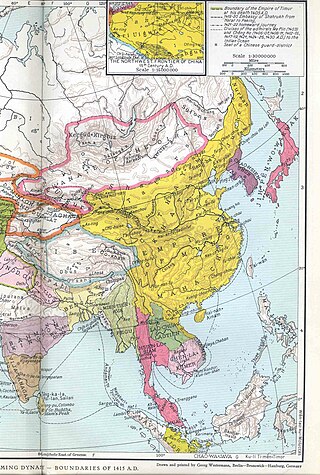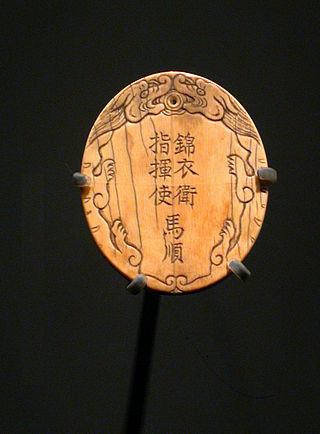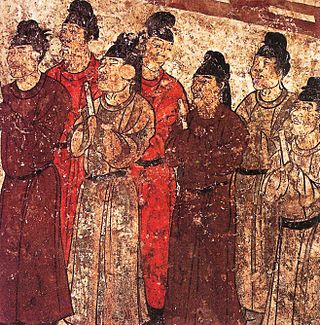Related Research Articles

The Ming dynasty, officially the Great Ming, was an imperial dynasty of China, ruling from 1368 to 1644 following the collapse of the Mongol-led Yuan dynasty. The Ming dynasty was the last imperial dynasty of China ruled by the Han people, the majority ethnic group in China. Although the primary capital of Beijing fell in 1644 to a rebellion led by Li Zicheng, numerous rump regimes ruled by remnants of the Ming imperial family—collectively called the Southern Ming—survived until 1662.

The House of Aisin-Gioro is a Manchu clan that ruled the Later Jin dynasty (1616–1636), the Qing dynasty (1636–1912), and Manchukuo (1932–1945) in the history of China. Under the Ming dynasty, members of the Aisin Gioro clan served as chiefs of the Jianzhou Jurchens, one of the three major Jurchen tribes at this time. Qing bannermen passed through the gates of the Great Wall in 1644, and eventually conquered the short-lived Shun dynasty, Xi dynasty and Southern Ming dynasty. After gaining total control of China proper, the Qing dynasty later expanded into other adjacent regions, including Xinjiang, Tibet, Outer Mongolia, and Taiwan. The dynasty reached its zenith during the High Qing era and under the Qianlong Emperor, who reigned from 1735 to 1796. This reign was followed by a century of gradual decline.

Mount Qingcheng is a sacred Taoist mountain in Dujiangyan, Chengdu, Sichuan, China.

The Embroidered Uniform Guard was the imperial secret police that served the emperors of the Ming dynasty in China. The guard was founded by the Hongwu Emperor in 1368 to serve as his personal bodyguards. In 1369 it became an imperial military body. They were given the authority to overrule judicial proceedings in prosecutions with full autonomy in arresting, interrogating and punishing anyone, including nobles and the emperor's relatives.

Hu Dahai, courtesy name Tongfu (通甫), was a Chinese Muslim and military general who lived in the 14th century. He is best known for helping Zhu Yuanzhang establish the Ming dynasty in China.
The 1642 Yellow River flood or Kaifeng flood was a man-made disaster in October, 1642, that principally affected Kaifeng and Xuzhou.

Wang Zhen was the first Ming dynasty eunuch with power in the court. He served Zhu Qizhen who promoted him to become 'one of the most powerful eunuch "dictators" in Ming history'.

Zhanjiao Futou, was the headwear of officials in medieval Chinese dynasties dated from Song to Ming. It consisted of a black hat with two wing-like flaps. The thin flaps were stiff and straight, and could extend up to almost a meter each.
Yishiha was a Jurchen eunuch of the Ming dynasty of China. He served the Ming emperors who commissioned several expeditions down the Songhua and Amur Rivers during the period of Ming rule of Manchuria, and is credited with the construction of the only two Ming dynasty Buddhist temples ever built on the territory of present-day Russia.
Nguyễn An, known in Chinese as Ruan An (pinyin) or Juan An (Wade-Giles), was a Ming dynasty architect and hydraulics specialist between the first and fifth decades of the 15th century. According to some sources, he was a key architect in designing, planning and constructing of the Forbidden City during the Ming dynasty. Born in Vietnam, he was taken as tribute to China and later became a eunuch and architect in service to the Chinese emperors. He, along with other architects, such as master designers and planners Cai Xin (蔡信), Kuai Xiang (蒯祥), Chen Gui (陳珪), and Wu Zhong (吳中), was a builder of the Forbidden City in Beijing.
The 1375 Yellow River flood was a natural disaster affecting the area around Kaifeng, China during the early Ming dynasty. Contemporary sources mentioned a death toll of between 15,000 and 25,000 people, most of them farmers. The philosopher Wang Yangming mentioned the 1375 Yellow River flood as an example of how even a virtuous man can be destroyed by the power of nature.
The 1384 Yellow River flood was a natural disaster affecting the area around Kaifeng, China, during the early Ming dynasty.
The 1390 Yellow River flood was a natural disaster affecting the area around Kaifeng, China, during the early Ming dynasty.
The 1416 Yellow River flood was a natural disaster affecting the area around Kaifeng, China, during the early Ming dynasty. The flood spilled over into fourteen other counties and seriously disturbed the Huai River.
The 1441 Yangtze flood was a natural disaster affecting the area around Nanjing, China, during the Ming dynasty.
The 1391 Yellow River flood was a major natural disaster during the early Ming dynasty in China.
The 1453 Yellow River flood was a natural disaster in the area surrounding Shawan in Shandong, China, during the Ming dynasty. The banks – repaired just the year before – burst again in the fourth lunar month and again in the fifth.

The 1494 Yellow River flood was a natural disaster in China during the Ming dynasty.
Eastern Depot or Eastern Bureau was a Ming dynasty spy and secret police agency run by eunuchs. It was created by the Yongle Emperor.

A eunuch is a man who has been castrated. Throughout history, castration often served a specific social function. In China, castration included removal of the penis as well as the testicles. Both organs were cut off with a knife at the same time.
References
- ↑ Tsai, Shih-Shan Henry.SUNY Series in Chinese Local Studies: The Eunuchs in the Ming Dynasty . SUNY Press, 1996. ISBN 0791426874, 9780791426876. Accessed 16 Oct 2012.